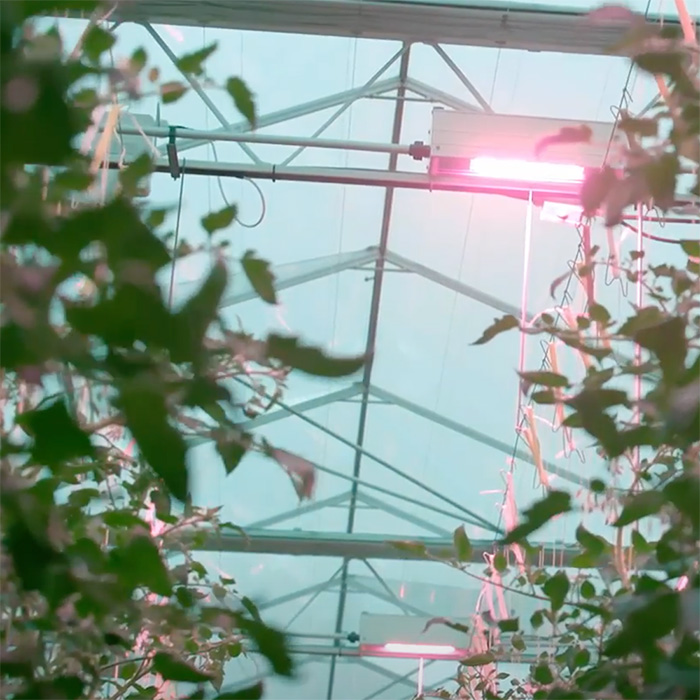Here at Westland Projects US Inc., we always want to use the best products out there, which is why we depend on Oreon LED grow lights. But before we go into the details of this brand, let’s learn more about greenhouse grow lights and what makes LED lights the go-to choice for commercial greenhouse setups.
What Are Greenhouse Grow Lights?
Grow lights get their name from their purpose: to help plants grow. There are various types of grow lights on the market, but they all function in generally the same way. They produce light that mimics the sun in a way that assists plants through their growth cycle.
Each version of greenhouse grow lights has its advantages and disadvantages. The main features to consider for grow lights include:
- Functionality in colder climates
- Lifespan
- Colour temperature (K)
- Indoor/Outdoor use
- Shape and appearance
- Cost
The three most common types of grow lights are explained in greater detail below.
High-Intensity Discharge Lights
High-intensity discharge (HID) lights produce some of the strongest rays available on the market. They work by using a glass tube containing gases and metal salts. On either end of the tube are tungsten electrodes. When electricity is passed between the electrodes, it produces light in the tube.
HID lights come in two primary forms: metal halide (MH) and high-pressure sodium (HPS). MH lights have a cool or blue-green colour temperature and are suitable for indoor and outdoor use. HPS lights have a warm (yellow-red) colour temperature, making them more similar to the sun’s rays. However, they can only be used outdoors and require more electricity to generate light, so they are not ideal for commercial greenhouse lighting.
Compact Fluorescent
Compact fluorescent (CFL) lights work similarly to HID lights in that they utilize a glass tube filled with a small amount of mercury and argon or some other inert gas. The tube has electrodes on each end, so when electricity passes between them through the tube, light gets produced.
What makes CFL a popular form of lighting for greenhouse horticulture is that it produces wavelengths very similar to the sun but without creating too much heat. The intensity of the wavelengths is much lower than that of the sun, though. Therefore, for commercial greenhouse lighting, you’ll need to invest in many CFL bulbs.
Light Emitting Diode
Light-emitting diodes or LED grow lights work differently from their above counterparts. Rather than using a glass tube and electrodes to produce light, LEDs pass a current between two alloys, type P (missing electrons) and type N (many free electrons). When the current, usually produced by a battery, passes between the alloys, it moves the electrons around, creating light.
LED grow lights have become a prevalent form of lighting for greenhouse horticulture in recent years. Let’s discover more about what makes this lighting so beneficial.
Benefits of LED Grow Lights for Greenhouse Horticulture
LED grow lights have several benefits, such as:
Efficiency
The high efficiency of LED grow lights really sets them apart from their competitors. Because they require less energy to operate, they can lower your energy bills dramatically. Plus, they produce very little heat, meaning you won’t have to worry about your greenhouse temperatures fluctuating based on light usage.
Oreon LED lighting, for example, uses a water-cooling system to ensure each fixture and its components remain cool. This technology means the extracted heat can be reused, making them even more energy efficient.
Sustainability
The lifespan of LED grow lights makes them incredibly sustainable over time. Most LED lights will function for at least 50,000 hours before they need changing. This longevity adds further to their energy efficiency and helps keep them out of landfills and recycling centers, making them more environmentally friendly. They also don’t contain any mercury or lead, something necessary for fluorescent bulbs to function.
Versatility
When it comes to Oreon LED lighting, you have a lot of options. Whether you go with their Embrace, Monarch, or Empress design, you’re getting high-quality Oreon greenhouse lighting with an impressive colour temperature range. That means you can grow whatever plants you want in the fastest time possible, without sacrificing on quality.
Oreon Embrace
Oreon greenhouse lighting is reliable and efficient. Its Embrace model is ideal for vertical and indoor farming since it uses the company’s water-cooled system to maintain desired levels of heat and humidity in your greenhouse. Ensuring your indoor environment’s stability is crucial for successful yields.
Oreon Monarch
The compact size of Oreon’s Monarch fixture may be deceiving at first. However, this Oreon lighting system is the most powerful LED option on the market and can produce two times more light than the best HPS light fixtures. It also maintains high-efficiency levels by taking advantage of Oreon’s water-cooling design.
Oreon Empress
If you’re looking for lighting with various light spectra, the Empress provides wide or narrow beam angles. This feature allows you to adjust the Oreon lighting system to match whatever your crops require. At the same time, the Empress maintains its efficiency with the same water-cooling system while minimally blocking sunlight due to its compact design.
Key LED Grow Light Specs
For those interested in learning more about the science behind grow lights and what makes them so valuable, here are some specifications you can become familiar with regarding lighting.
Watts
Most of us are familiar with “watts,” even if we aren’t in the lighting business. In the most simple terms, a watt is a unit of measurement to show how much electric power a light uses. For instance, a standard incandescent light bulb is 60 watts, or 60W.
The more watts a light needs, the less efficient it will be. However, when it comes to LED lights, the strength of the light is not directly correlated to its watts. Instead, the strength of an LED depends more on its design and the quality of its components.
That’s why, even though an LED light’s efficiency goes down when watts go up, it will still produce a brighter light—known as lumens—than other types of bulbs. In specific ways, this brightness counteracts the bulb’s inefficiency based on watt usage.
Lumens
Essentially, lumens are how we measure the brightness of a light. It estimates how much visible light gets emitted from a source. Knowing a grow light’s lumens measurement is helpful to ensure it matches with the types of plants you intend to grow. Without the right amount of lumens, your plants won’t be able to absorb enough light to develop fully, if at all.
A ten-watt LED light produces around 900 lumens, and most greenhouse plants will want approximately 20,000 lumens per square meter of growth.
Lux
Speaking of square meters, lux is simply lumens per meter squared. For commercial greenhouse growers, knowing your lux is often more valuable than knowing your light’s lumens since you want to determine the amount of lighting that reaches your plants.
However, we still measure lux based on the light visible to humans, not plants, so it still doesn’t give a complete picture of your plants’ needs. That’s where PAR comes in.
PAR
PAR stands for photosynthetically active radiation. These are the wavelengths plants need to thrive, which includes most of the visible light spectrum. During their vegetative state, plants prefer blue colours, ranging from 400-500 nanometers in wavelength. Once plants reach their flowering stage, they thrive under red wavelengths, between 620 and 780 nanometers.
High-quality LED grow lights like those offered by Oreon take this information into account when designing and creating their lighting systems. With LED lights, you can easily switch between wavelengths—and, therefore, light colour—so that your greenhouse plants are in their ideal environment, regardless of which growth stage they are experiencing.
LED Grow Light Distance from Plants
At this point, it should be reasonably obvious why using LED grow lights is the ideal setup for commercial greenhouse growers. However, if you’re looking just to switch out your old fluorescent bulbs for LEDs, you still need to make some adjustments to your setup.
Probably the most critical change to make when switching to LED grow lights is how far you place them from your plants. You’ll need to consider how much space you have to work with, as this will affect how many watts you’ll want for each square meter.
For instance, an area that is one square meter needs around 400W, while a space that is a square meter and a half needs closer to 1,000W.
If you’re utilizing LED grow lights with 1W bulbs, you’ll want to hang them about 30 centimetres above your plants. For LED grow lights between 3W and 5W, you’ll want to go a bit higher, closer to 45 centimetres. For high-wattage setups, you’ll need to arrange your LED lights at least 75 centimetres up.
If you’re unsure about the best arrangement for your greenhouse, feel free to reach out to Westland Projects US Inc. for assistance.
Heat and LED Grow Lights
Another important consideration when using LED grow lights is that they produce much less heat than their counterparts. A high-quality LED grow light like those produced by Oreon will have temperatures as low as 21°C, whereas an HPS bulb can create temperatures as high as 34°C.
While you may think it’s good for your greenhouse plants to be exposed to heat since that’s what would happen in nature, it’s not always that straightforward.
Too much heat bearing down on your plants for hours on end is not actually what happens in nature. So, if you set your greenhouse lights on 12 hours per day and they produce temperatures as high as 34°C, it would be like your plants sitting out in the midday sun for half the day.
Not only could this dry out and even burn your plants, but it also reduces the visible light output of your setup, making it less effective. Add it all up, and that excess heat is costing you a lot of money. Ultimately, this is why opting for LED grow lights in your greenhouse makes the most sense.
Scalability and LED Grow Lights
A final reason to consider LED grow lights, particularly for commercial greenhouse growers, is their scalability. Their benefits, such as high efficiency, long lifespan, low heat output, and using standard electrical outlets, make them highly scalable.
Anytime you need to expand or revise your greenhouse setup or capacity, LED grow lights will easily adjust accordingly. And even though they have a higher upfront cost than other greenhouse lighting options, the investment will be worth it in the long run as your productivity and yields will increase substantially.
Get in Touch with Westland Projects US Inc.
As LED grow lights expand into the horticulture business, there are many options out there to choose from, and it can feel overwhelming. We’ve done the research here at Westland Projects US Inc., and we believe Oreon provides the best LED light solutions for commercial greenhouse growers.
However, ideal lighting is just one aspect of creating the most fruitful commercial greenhouse space possible.
If you’re looking to start or expand your greenhouse business but aren’t sure what steps to take next, let Westland Projects US Inc. help. Our experience in the greenhouse industry allows us to provide total solutions for projects of any size.
We can install, supply, and maintain greenhouse projects that will be on time and budget. Whether you need assistance with consultation and design, construction, shade and blackout installation, systems maintenance, or all of the above, we can be there every step of the way. Contact us today!



